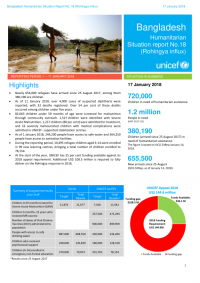Bangladesh: Humanitarian Situation (Rohingya influx)

Highlights
Nearly 656,000 refugees have arrived since 25 August 2017, among them 380,190 are children.
As of 11 January 2018, over 4,000 cases of suspected diphtheria were reported, with 32 deaths registered. Over 54 per cent of these deaths occurred among children under five years.
82,063 children under 59 months of age were screened for malnutrition through community outreach. 1,527 children were identified with Severe Acute Malnutrition, 1,217 children (80 per cent) were admitted for treatment, and 16 severely malnourished children with medical complications were admitted in UNICEF- supported stabilization centres.
As of 1 January 2018, 244,200 people have access to safe water and 364,250 people have access to sanitation facilities.
During the reporting period, 10,495 refugee children aged 4-14 were enrolled in 99 new learning centres, bringing a total number of children enrolled to 78,154.
At the start of the year, UNICEF has 25 per cent funding available against its 2018 appeal requirement. Additional US$ 108.5 million is required to fully deliver on the Rohingya response in 2018.
Situation Overview and Humanitarian Needs
As of 14 January 2018, the Inter-Sector Coordination Group (ISCG) reported that almost 656,000 Rohingya refugees have entered Bangladesh since the attacks. According to ISCG’s rapid needs assessment, 58 per cent of new arrivals are children and 60 per cent are girl children and women including a high number of pregnant (3 per cent) and lactating women (7 per cent). The estimated total affected population of existing refugees, new arrivals and host communities is 1.2 million people. This includes 720,000 affected children in need of urgent humanitarian assistance including critical life-saving interventions.
Existing basic services for refugees and host communities have been overwhelmed due to the sudden and massive increase in population. The high population density in the settlements has increased the risk of disease outbreaks and 1.2 million people urgently require water and sanitation services. More than 17 million litres of clean water per day are needed and approximately 50,000 latrines with semi-permanent structures need to be constructed and maintained. Vaccination coverage amongst new arrivals is very low and deadly outbreaks of communicable diseases (measles and diphtheria) have already occurred. In the densely populated settlements, with poor sanitation and hygiene conditions, an outbreak of cholera or acute watery diarrhoea (AWD) is a risk that will be considered in the rainy/cyclone season preparation plan. Urgent nutrition needs have been prioritized for children aged under five (including infants), pregnant and lactating women (PLW) and adolescent girls with 3 per cent of children suffering from life-threatening severe acute malnutrition (SAM) in the biggest settlement (Kutupalong). An estimated 400,000 Rohingya children are also in need of psychosocial support and other protection and education services.
The inter-agency Humanitarian Response Plan (HRP), covering period of September 2017 to February 2018 identified the areas of WASH, health, nutrition and food security and shelter for immediate scale-up to save lives in both settlements and host communities. As the response is pursued, the “Rohingya Refugee Crisis Joint Response Plan” covering the period from March to December 2018 will ensure that the needs of the most vulnerable population will continue to be addressed. UNICEF 2018 HAC was developed prior to the upcoming inter-agency Joint Response Plan (JRP) and will therefore be revisited later to ensure full alignment with JRP.
